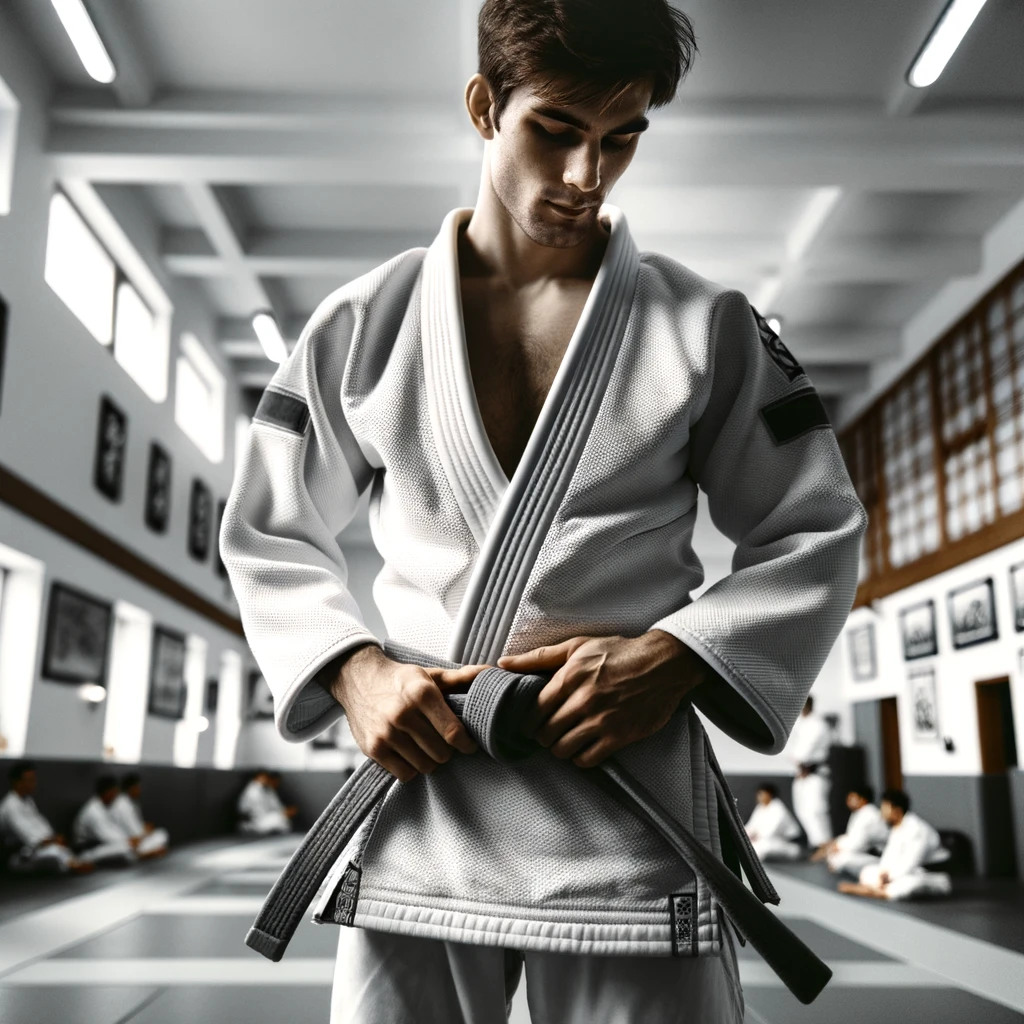How to Tie a BJJ Belt: Learn the Basics (2024)
Thanks for checking out this unbiased article on How To Tie a BJJ Belt. Navigating the world of Brazilian Jiu-Jitsu (BJJ) can be as complex as a well-executed sweep or guard pass, especially when you’re new to the mats.
One of the first hurdles every practitioner faces isn’t learning the latest submission; it’s mastering the art of tying their belt. This seemingly simple task can be surprisingly daunting, reflecting your dedication and respect towards the martial art.
Tying your belt correctly is more than a ritual; it’s a rite of passage. A loose or poorly tied belt not only disrupts the flow of training but can also be seen as a sign of disrespect towards the sport and your fellow practitioners.
It’s a silent communicator of your attention to detail and commitment. Yet, many newcomers find themselves tangled in knots, both literally and figuratively, as they try to secure their belts.
Fear not, as this guide is designed to demystify the process, providing a step-by-step tutorial that will ensure your belt is tied perfectly every time you step onto the mat.
From selecting the right belt size to achieving the ideal knot that won’t come undone mid-roll, we’ve got you covered. By the end of this article, tying your BJJ belt will feel as natural as a well-practiced armbar.
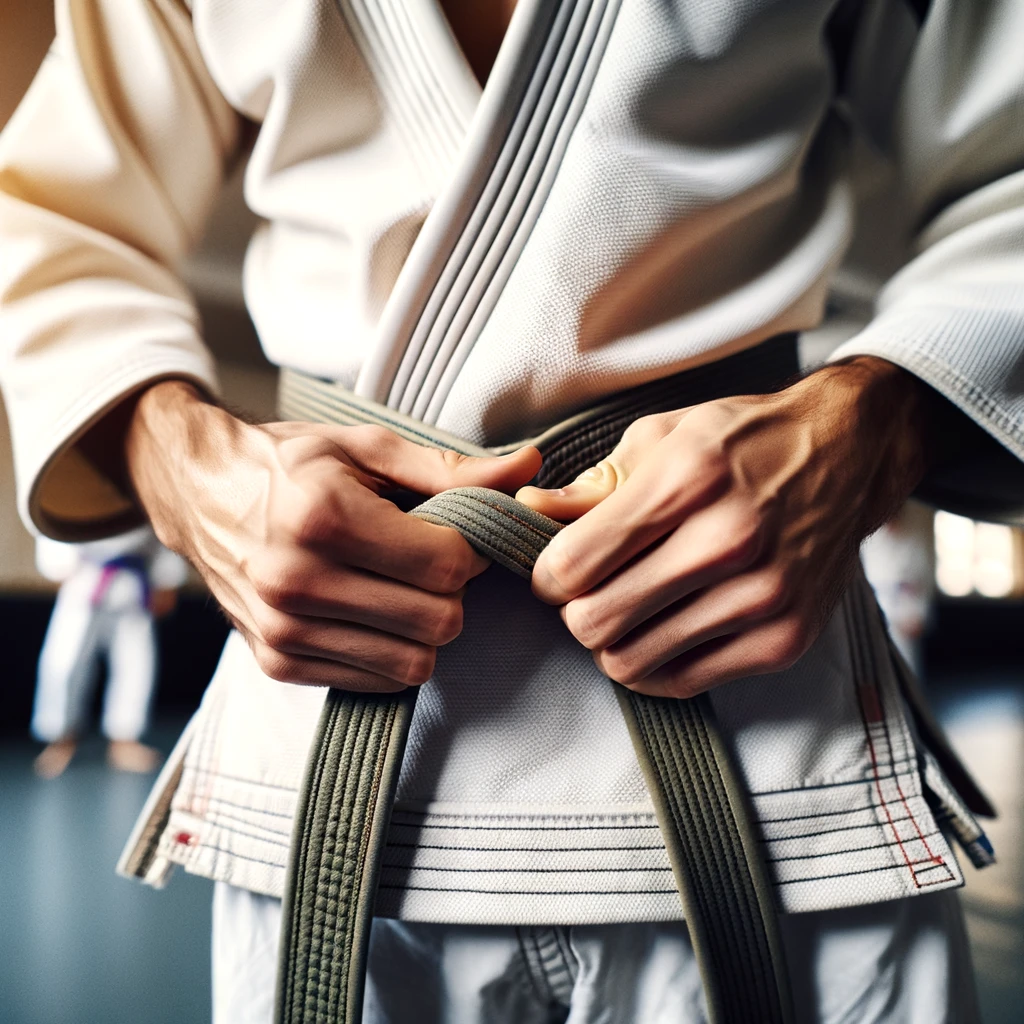
How to Tie a BJJ Belt?
The Importance of Tying Your Belt Correctly
Tying your BJJ belt correctly is a fundamental aspect of Brazilian Jiu-Jitsu that extends beyond mere appearance. It is a testament to your dedication to the martial art, a sign of respect to your instructors and peers, and a necessary skill to ensure safety during training.
Why It Matters
The way you tie your belt in BJJ is not just about keeping your gi together; it’s a reflection of your discipline and readiness to train. A properly tied belt doesn’t come undone easily, ensuring that training sessions are not interrupted.
Furthermore, it shows respect towards the traditions of Brazilian Jiu-Jitsu. Instructors and fellow students often perceive a well-tied belt as a sign of a serious and dedicated practitioner.
Symbolism in BJJ
In BJJ, the belt is more than just a functional accessory; it carries a wealth of symbolism. It represents your journey, achievements, and the time you’ve dedicated to learning and refining your skills.
Each belt color signifies a different level of knowledge and expertise, making the act of tying it correctly all the more important. It’s a sign of honoring the journey you’re on and the art you’re learning.
Selecting the Right Belt
Choosing the correct belt is crucial for comfort, appearance, and performance on the mat. Here’s how to select the right belt for your training needs.
Understanding Belt Sizes
Belts come in various lengths, typically correlating with your gi size. However, factors like your waist size and personal preference on belt length (some practitioners prefer longer tails after the knot) play a significant role.
A rule of thumb is that your belt should wrap around your waist twice with enough length remaining to tie a proper knot, leaving about 20-30 cm (8-12 inches) of tail on each side.
Tips for Choosing Your Belt
- Fabric: Consider the material of the belt. Cotton belts are durable and easy to clean, while hemp belts offer antimicrobial properties and environmental benefits.
- Thickness: Some belts are thicker than others, which can affect how easily you can tie and untie them. Thicker belts might stay tied better but can be more challenging to knot tightly at first.
- Brand and color fastness: Look for brands known for quality. Some belts are more prone to fading than others, which can be a concern if you train frequently or compete.
Choosing the right belt sets the foundation for your BJJ journey, ensuring comfort, durability, and compliance with the traditions and standards of the sport.
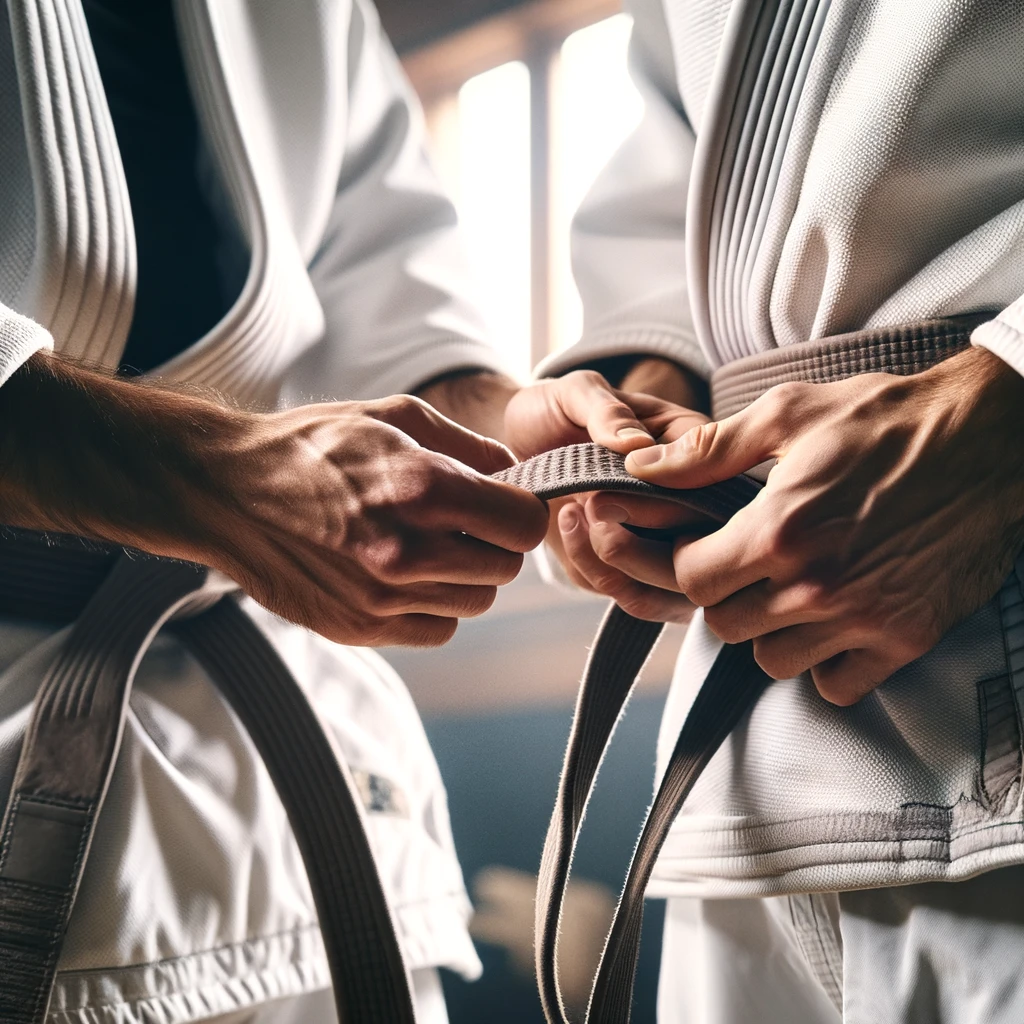
Step-by-Step Guide to Tying Your BJJ Belt
Mastering the art of tying your BJJ belt is crucial for every practitioner. Follow this comprehensive guide to ensure your belt is secure, looks great, and respects the tradition of Brazilian Jiu-Jitsu.
Preparing the Belt
Before you begin, make sure your belt is laid out straight without any twists or knots. Starting with a properly aligned belt will make the tying process smoother and ensure the final look is neat and tidy.
The Basic Knot
The basic knot is the foundation of tying your BJJ belt. Here’s how to execute it:
- Centering the Belt: Hold your belt out in front of you and fold it in half to find the center. Place the center on your stomach, just below your navel, with the belt wrapping around your waist to meet back in front.
- First Wrap: With both ends in front, cross the right end over the left, bringing it underneath both layers of the belt to create the first layer of the knot.
- Second Wrap and Knot: Cross the left end over the right and pull it up through the loop you just created. Tighten by pulling both ends horizontally to ensure the belt sits snugly around your waist.
The Double Wrap Method
For those who prefer a more secure fit or have a longer belt, the double wrap method adds an extra layer of security.
- Initial Wrap: Similar to the basic knot, start by finding the center of your belt and wrapping it around your waist once, ensuring the ends meet in front of you.
- Second Loop: Instead of immediately tying the knot, take each end and wrap it around your waist again, following the same path as the initial wrap. You should now have two layers of belt around your waist.
- Final Knot: With the ends back in front, tie them using the basic knot method. This double wrap ensures your belt is less likely to come undone during training.
Ensuring a Secure Knot
To ensure your belt stays tied throughout your training session, give special attention to how tight you pull the ends when tying the knot.
The knot should be tight enough to secure the belt but not so tight that it becomes uncomfortable or restricts your movement. After tying the knot, give it a gentle tug to ensure it’s snug and secure.
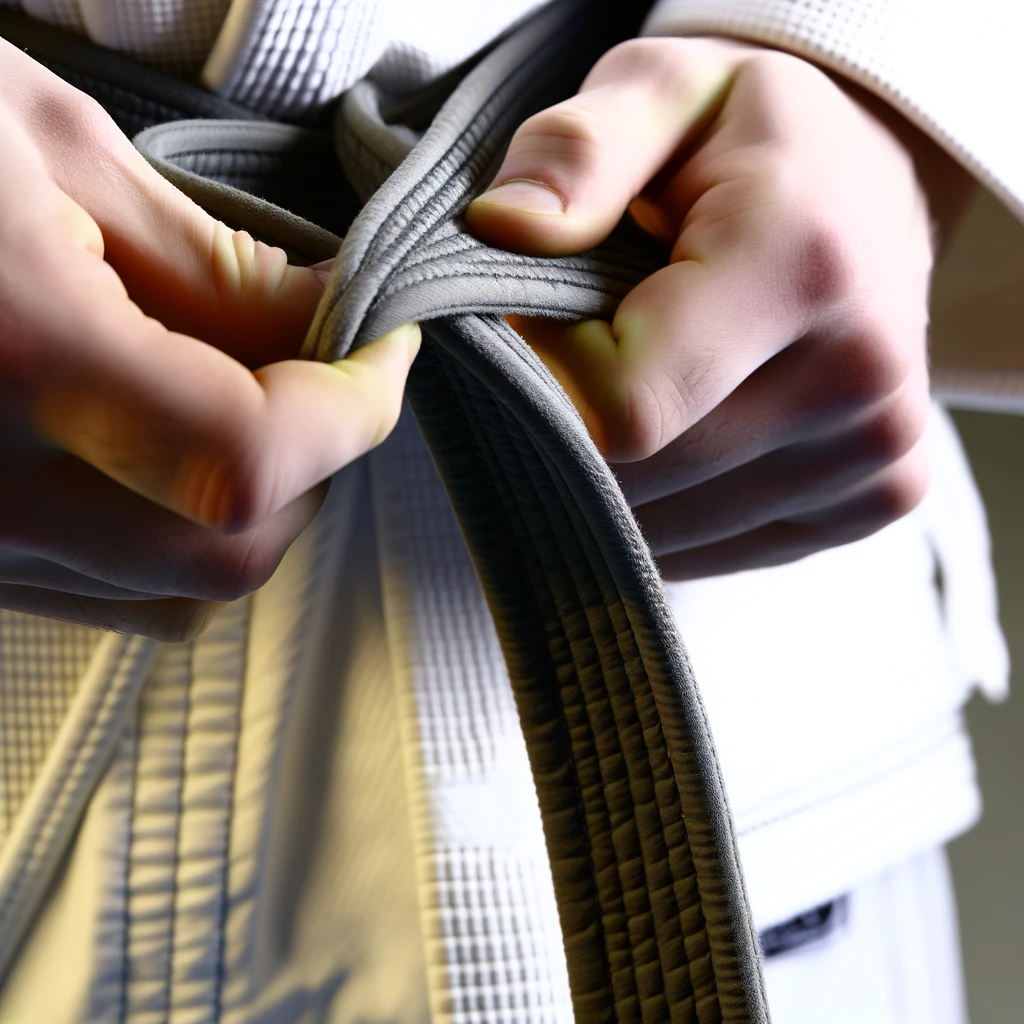
Common Mistakes and How to Avoid Them
Too Loose or Too Tight
One common mistake is tying the belt too loose, causing it to come undone easily, or too tight, restricting movement. Find a balance by ensuring the belt is snug but allows for full range of motion.
Uneven Ends
Ensure both ends of the belt are of equal length after tying. Uneven ends can look untidy and may indicate the belt was not wrapped evenly around the waist.
The Belt Comes Undone Easily
If your belt comes undone frequently, revisit the steps for the double wrap method or ensure you’re pulling the ends tightly enough when forming the knot. A well-tied belt should stay secure through most training sessions.
Advanced Tips for Belt Tying
Once you’ve mastered the basics of tying your BJJ belt, these advanced tips will help you ensure that your belt is not only secure but also represents your commitment to the art of Brazilian Jiu-Jitsu with every knot.
How to Achieve the Perfect Fit
Achieving the perfect fit with your belt is about more than just keeping your gi closed; it’s about comfort and functionality. Here are some tips:
- Adjust Tightness: After wrapping your belt around your waist, adjust its tightness by pulling on the ends before you tie the knot. This ensures the belt is snug but not constricting.
- Even Pressure: Ensure that the pressure around your waist is even throughout the belt’s length before tying the knot. This helps in maintaining comfort and preventing any part of the belt from becoming too tight.
Techniques for Longevity
To make sure your belt lasts as long as possible, consider these techniques:
- Proper Storage: Avoid crumpling up your belt after class. Instead, roll it up or hang it straight to prevent creases and maintain its shape.
- Regular Cleaning: While it’s not necessary to wash your belt after every class, regular cleaning according to the manufacturer’s instructions helps maintain its integrity and appearance. Be mindful of the washing temperature and recommendations to avoid excessive fading.
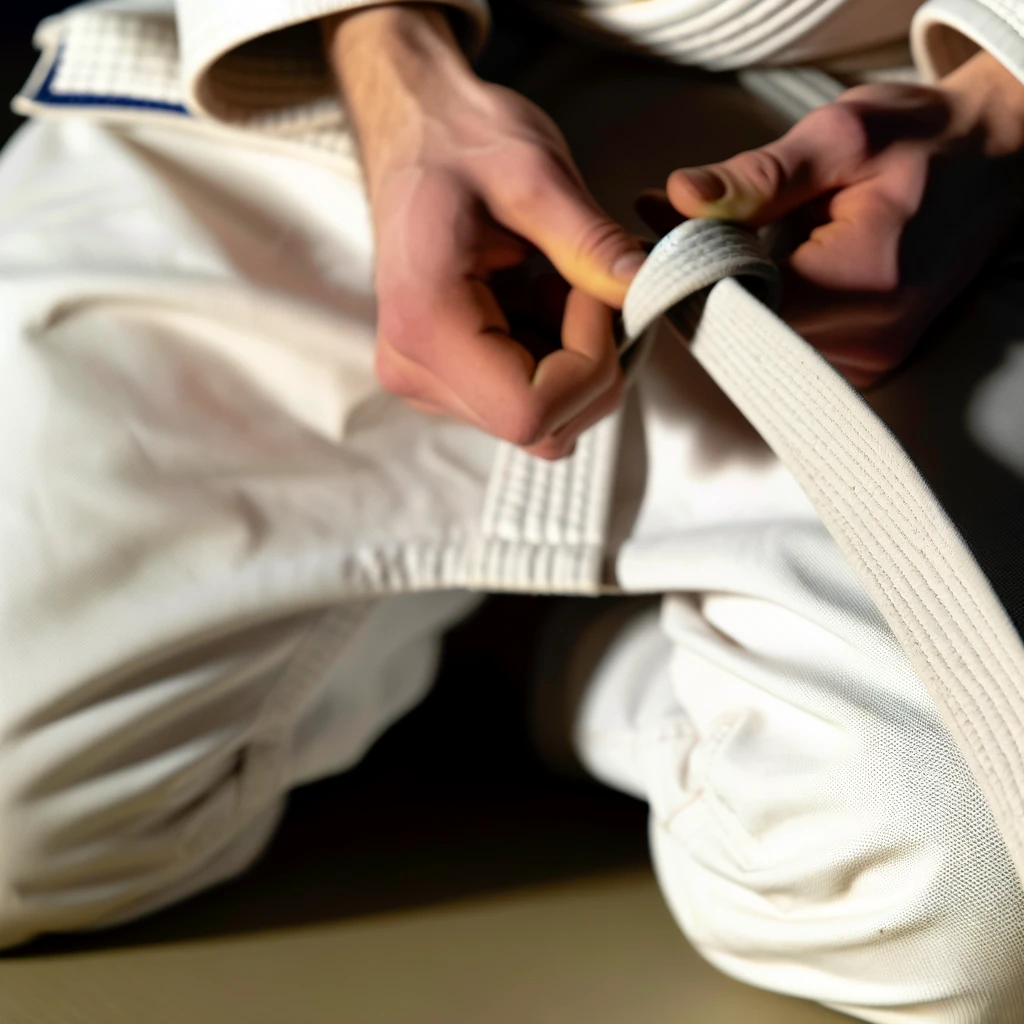
The Role of the Belt in BJJ Culture
Understanding the role of the belt in BJJ culture is crucial for every practitioner. It’s a symbol of your journey, your achievements, and your dedication to the martial art.
Belt Ranks and What They Signify
Each belt color in BJJ represents a different stage in your journey, from the white belt, symbolizing a beginner, to the black belt, representing a high level of expertise and dedication.
Knowing the significance of each color helps practitioners respect the journey and the achievements of others.
Respecting the Belt and What It Represents
The belt is not just a tool to keep your gi in place; it’s a representation of your commitment, your learning, and your growth in BJJ.
Respecting your belt means taking care of it, tying it correctly, and understanding its significance in the broader BJJ culture. It’s a sign of respect to the art, your instructors, and fellow practitioners.
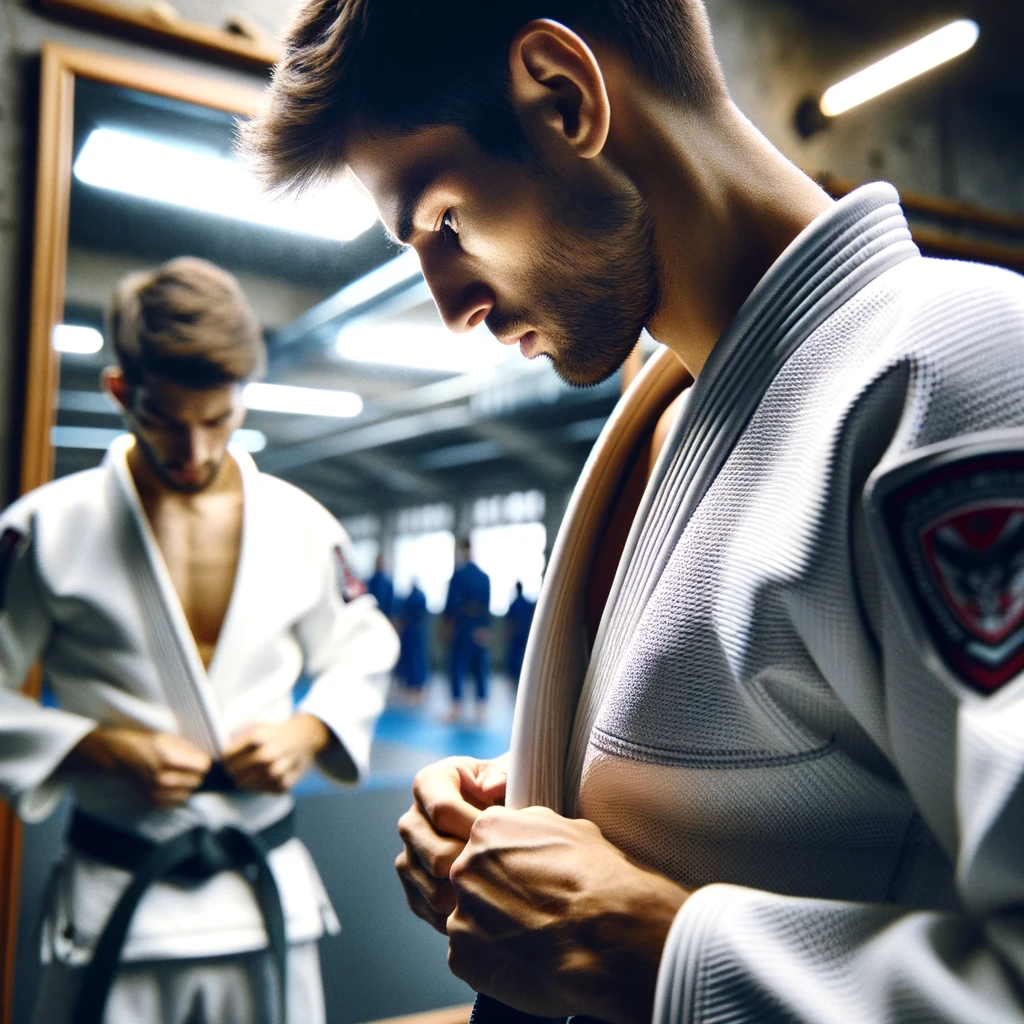
Caring for Your BJJ Belt
Proper care for your BJJ belt extends its lifespan and ensures it continues to represent your journey accurately.
Washing and Maintenance
While belts do not require as frequent washing as gis, keeping them clean is essential for hygiene and longevity. Follow the manufacturer’s guidelines for washing and drying to prevent shrinkage and fading.
When to Replace Your Belt
Over time, your belt will show signs of wear. While some wear is a badge of honor, reflecting your hard work and dedication, a belt that becomes frayed or torn may need to be replaced.
It’s essential to balance the history your belt represents with the need for a presentable, intact piece of your BJJ uniform.

Conclusion
Thanks for checking out this article on How To Tie a BJJ Belt. Whether you’re stepping onto the mat for the first time or you’re a seasoned practitioner looking to refine your knowledge, understanding how to correctly tie your belt is fundamental in Brazilian Jiu-Jitsu.
It’s a practice that signifies not only your readiness to train but also your respect for the art and its traditions.
As we’ve explored, tying your belt correctly goes beyond mere functionality. It’s about ensuring your belt is secure throughout your training, showing respect to your instructors and peers, and maintaining the integrity of your BJJ gi.
Remember, the journey in BJJ is long and filled with learning, both on and off the mat. Mastering the simple, yet profound act of tying your belt is a step towards embracing the discipline, culture, and community of Brazilian Jiu-Jitsu.
Keep practicing, stay dedicated, and let every knot you tie reflect your commitment to this beautiful martial art.

FAQs
Is there a right way to tie a BJJ belt?
Yes, there is a right way to tie a BJJ belt to ensure it stays secure during grappling sessions and reflects your respect for the art of Brazilian Jiu-Jitsu.
The standard method involves wrapping the belt around your waist, ensuring that the end of the belt on your left side comes over the top of the other end after wrapping around your waist twice.
The belt should be snug, with the knot sitting squarely in front of your belly button. This method creates a balanced look and prevents the belt from coming undone easily.
How do you tie a Gracie knot?
The Gracie knot, also known as the super lock or Hollywood knot, is a variation taught by members of the Gracie family, like Rener Gracie, to ensure the belt doesn’t come undone during training.
Start by wrapping the belt around your waist, then create belt layers by folding the right side of the belt over the left side, near your belly.
Pass the top tail (the end that’s now on your right) underneath all layers of your belt, pulling it up the middle of the belt before tying it in a standard knot. This creates a super lock effect, keeping the belt secure.
How do you tie a belt nicely?
To tie a belt nicely, focus on symmetry and securing the belt knot correctly. After wrapping the belt around your waist, ensure the ends of your belt are even and that the knot is tied at the center, directly over your belly button.
A square knot is preferred for a neat appearance, which is achieved by laying the right end over the left, then the left over the right, pulling both ends firmly. This method is not only aesthetically pleasing but also functional, reducing the chance of the belt coming undone.
How should a BJJ belt fit?
A BJJ belt should fit snugly around your waist, with the ends of the belt hanging approximately 20-30 centimeters (8-12 inches) from the knot. It should wrap around your waist twice, covering the lapel of your BJJ gi.
The belt’s fit is crucial for comfort and effectiveness in grappling scenarios, ensuring it doesn’t become a distraction or loosen easily during Jiu Jitsu training or competitions.
The right fit reflects your skill level and dedication to Brazilian Jiu Jitsu, akin to ranks in judo and karate.

